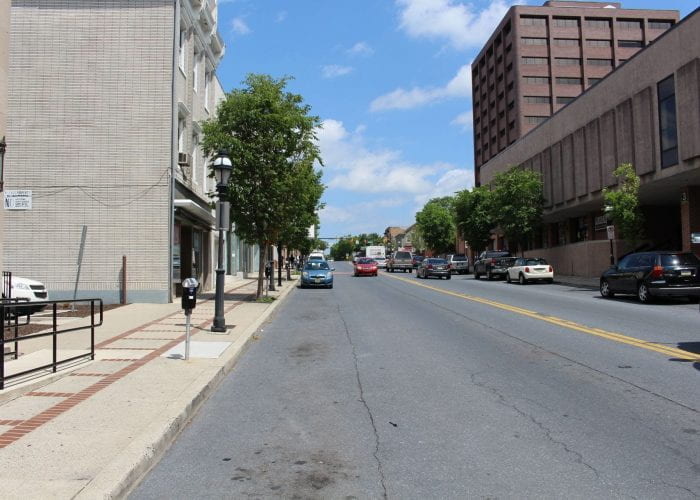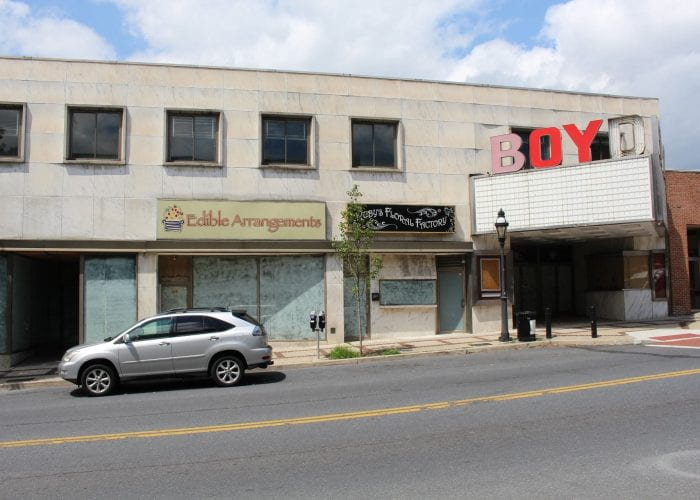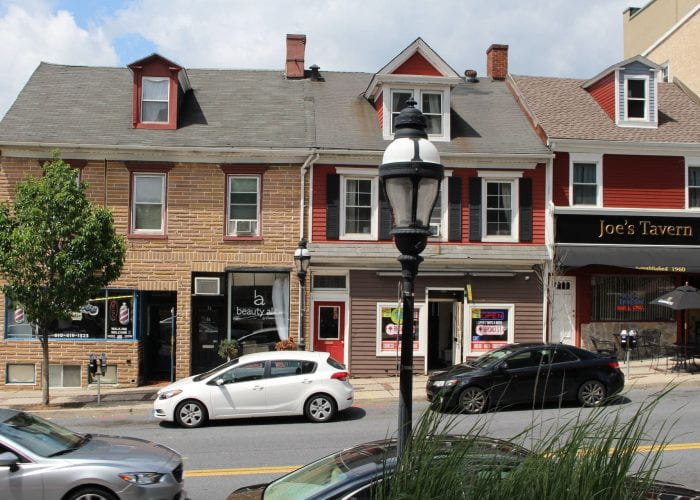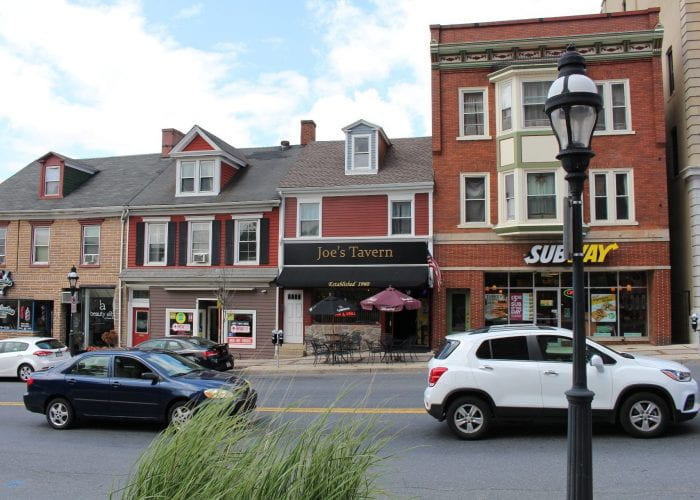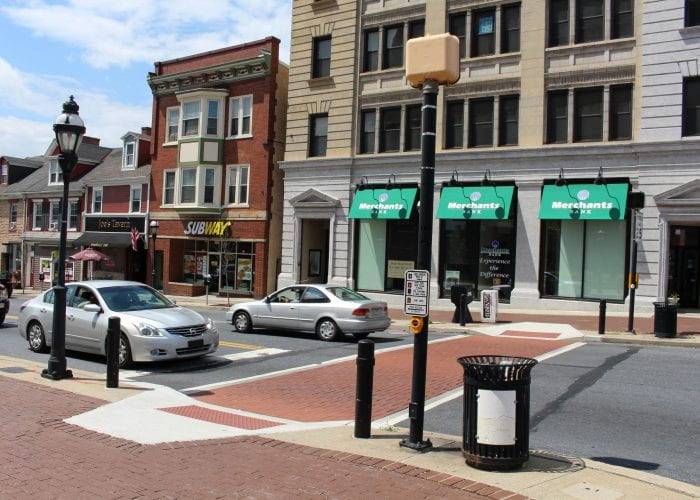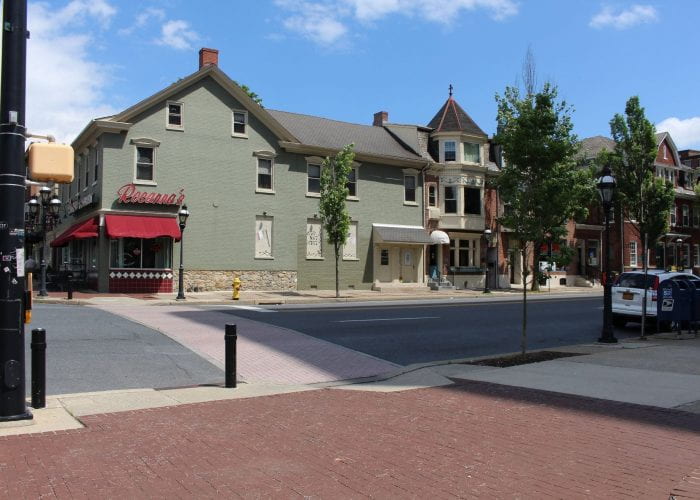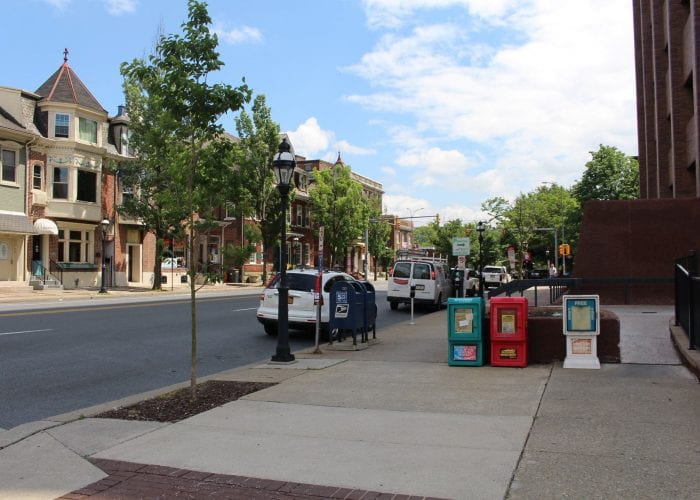Given our team’s goal of improving the pedestrian experience in the Broad St. neighborhood, it is important for us to collect data that speaks to pedestrian concerns. We used data collection tools designed to capture local perceptions of the Broad St., including the visitors’ sense of safety and comfort. Our data collection process consists of two key methods: survey research and naturalistic observation. In the sections below, we offer an overview of the tools, techniques, and methods we used to collect parklet data.
Survey Design
The survey consists of 24 questions divided into three sections: experience, design, and demographics. Parklet experience questions ask participants to describe what brought them to the specific section of Broad St. under observation. This section also asks participants to explain their perceptions of Broad St. and consider how the parklet influences those perceptions. Parklet design questions give participants the opportunity to rank specific aspects of the parklet construction and placement. After the numeric rating, participants can also explain their scores through a series of short answer questions. This section also asks participants to imagine additional events, amenities, and design elements they would like to see in future parklets. Demographics allow participants to self-record their age, gender, race, ethnicity, household income, and level of education.

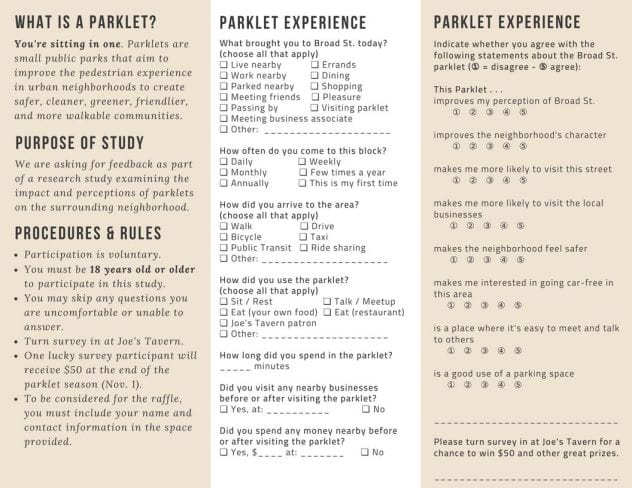
Survey Participants
Survey participants are voluntary and must be at least 18 years of age or older. Participants must have visited the Broad Street parklet at least once during the 2018 summer. Participants may choose to opt out of any questions they are uncomfortable answering. Surveys are located both onsite (as a trifold pamphlet, seen above) and online (as a Google Form). To encourage participation, we included a small financial incentive, allowing participants to enroll in a weekly, monthly, and grand-prize raffle. Once completed, surveys are collected by the staff at our on-site business partner, Joe’s Tavern.
Observation Design
We conduct regular on-site observations at the Broad St. parklet. In fifteen-minute intervals, the observer records the Group Size, Age, Gender, Activity, Time Spent on Street, and Method of Transportation for each person who enters the 1/2 block observation zone. We also record the Date, Day of Week, Weather, and Time as well as any Special Events that would significantly alter area traffic and individual behavior (such as a summer festival or a parklet-hosted event). Time of day is then coded into five grouping: Morning (8-11), Mid-day (11-2), Afternoon (2-5), Evening (5-8), and Night (8-11). These secondary observations allow us to check for trends and patterns across a wide range of variables.
Activity records the various activities individuals perform within the observation zone. These activities include public acts such as Passing Through, Parking, and Walking Dog as well as economic acts such as visiting one of the many businesses located in the observation zone. This Activity variable allows us to study how individuals who enter this section of Broad Street use its businesses amenities.
Time Spent on Street records the length of time (in minutes) everyone is spending within the observation zone. For those simply passing through the area (not stopping at any business using any public amenity), the time is recorded as zero. Otherwise, the time spent on the street is recorded up to the maximum of 15 minutes, or the full length of time we spend observing the street.
Method of Transportation records how an individual entered the observation zone and is recorded as one of three values: pedestrian, bicycle, or car. Individuals who park outside of the observation zone but enter it on foot are recorded as pedestrians. Individuals who drive through the observation zone but do not park or get out of their vehicle are not recorded.
Observation Zone – Broad Street @ Joe’s Tavern
The observation zone extends roughly one-quarter block in both directions of the Broad St. parklet (extending across the New Street intersection to the East and halfway to the Guetter Street intersection to the West).
The image slideshow below provides a visual tour of the Broad Street observation zone:
Observation Zone Amenities
The zone includes a variety of businesses and city amenities including:
- One LANTA bus stop (eastbound routes: 101, 102, 327, 215, 605, 217)
- 12 parking spots
- 11-story business plaza with patio, green space, and fountain out front
- Brick Pizza
- Rosanna’s Restaurant
- Pennsylvania Senator (Lisa Boscola) Bethlehem office
- The Melting Pot Restaurant
- Merchants Bank
- Subway
- Joe’s Tavern with small sidewalk patio out front
- PowerSchool
- Broad St. Mini Mart
- Beauty Alibi Salon
- Exclusive Cutz Barbershop
Observation Zone – 4th Street @ Roasted
The observation zone extends roughly one-quarter block in both directions of the 4th Street parklet (extending to the First Reformed Church to the East and the 4th/Vine intersection to the West).
Observation Zone Amenities
The zone includes a variety of businesses and city amenities including:
- 11 parking spaces (9 after parklet installation)
- Roasted Cafe
- First Reformed Church
- Official Cuts Barber Shop
- Perfect Nails Salon
- Homebase Clothing Store
- EZ Money Pawnbroker
- Vapor Galleria
- Hair By Eskandalo! Salon
Baseline Data
Baseline data was collected by observing the Broad Street observation zone for two weeks prior to parklet installation in 15-minute intervals. Over the course of this period, we observed nearly 1000 individuals in the observation zone, offering us a strong sample to which we can compare our parklet data.
Analysis
In mid-July, 2018, the Lehigh Valley parklet will begin analyzing the collected data. Please check back regularly for updates on how the summer 2018 Broad Street parklet impacts the surrounding community.
